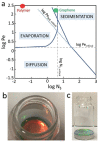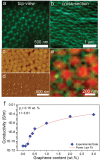Mechanochromic and Thermochromic Sensors Based on Graphene Infused Polymer Opals
- PMID: 32774202
- PMCID: PMC7406018
- DOI: 10.1002/adfm.202002473
Mechanochromic and Thermochromic Sensors Based on Graphene Infused Polymer Opals
Abstract
High quality opal-like photonic crystals containing graphene are fabricated using evaporation-driven self-assembly of soft polymer colloids. A miniscule amount of pristine graphene within a colloidal crystal lattice results in the formation of colloidal crystals with a strong angle-dependent structural color and a stop band that can be reversibly shifted across the visible spectrum. The crystals can be mechanically deformed or can reversibly change color as a function of their temperature, hence their sensitive mechanochromic and thermochromic response make them attractive candidates for a wide range of visual sensing applications. In particular, it is shown that the crystals are excellent candidates for visual strain sensors or integrated time-temperature indicators which act over large temperature windows. Given the versatility of these crystals, this method represents a simple, inexpensive, and scalable approach to produce multifunctional graphene infused synthetic opals and opens up exciting applications for novel solution-processable nanomaterial based photonics.
Keywords: colloidal crystals; mechanochromic sensors; pristine graphene; self‐assembly; time‐temperature indicators.
© 2020 The Authors. Published by WILEY‐VCH Verlag GmbH & Co. KGaA, Weinheim.
Conflict of interest statement
The authors declare no conflict of interest.
Figures







References
-
- Barnard A. S., Guo H., Nature's Nanostructures, Pan Stanford Publishing, Singapore: 2012.
-
- Zhou C., Gong X., Han J., Guo R., Soft Matter 2015, 11, 2555. - PubMed
-
- Zhang J., Sun Z., Yang B., Curr. Opin. Colloid Interface Sci. 2009, 14, 103.
-
- Zhang J., Li Y., Zhang X., Yang B., Adv. Mater. 2010, 22, 4249. - PubMed
-
- Lee H. S., Shim T. S., Hwang H., Yang S.‐M., Kim S.‐H., Chem. Mater. 2013, 25, 2684.
Grants and funding
LinkOut - more resources
Full Text Sources
Other Literature Sources
